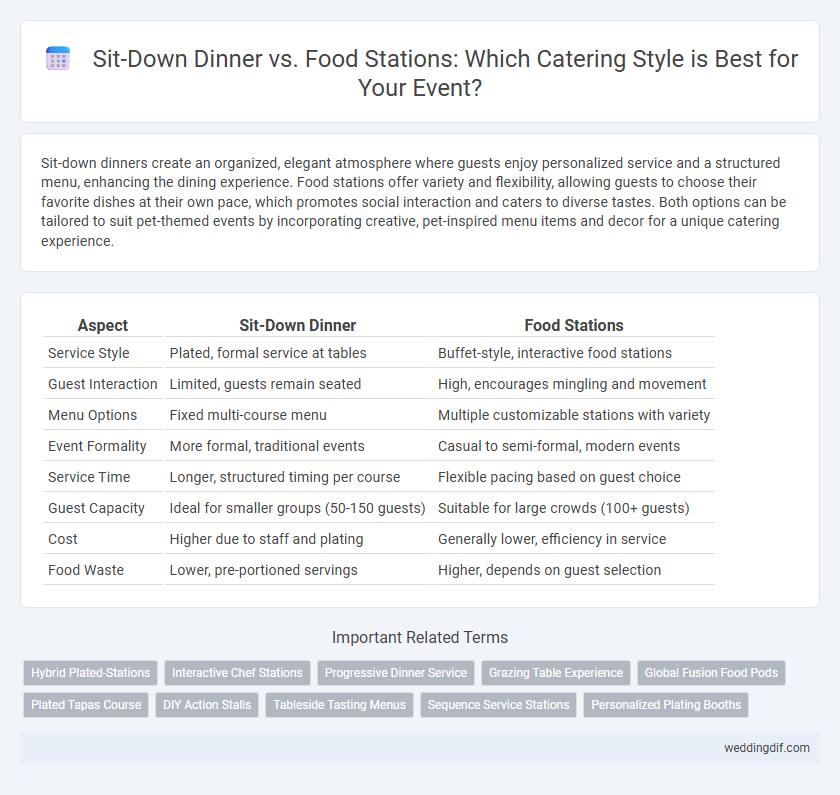Sit-down dinners create an organized, elegant atmosphere where guests enjoy personalized service and a structured menu, enhancing the dining experience. Food stations offer variety and flexibility, allowing guests to choose their favorite dishes at their own pace, which promotes social interaction and caters to diverse tastes. Both options can be tailored to suit pet-themed events by incorporating creative, pet-inspired menu items and decor for a unique catering experience.
Table of Comparison
| Aspect | Sit-Down Dinner | Food Stations |
|---|---|---|
| Service Style | Plated, formal service at tables | Buffet-style, interactive food stations |
| Guest Interaction | Limited, guests remain seated | High, encourages mingling and movement |
| Menu Options | Fixed multi-course menu | Multiple customizable stations with variety |
| Event Formality | More formal, traditional events | Casual to semi-formal, modern events |
| Service Time | Longer, structured timing per course | Flexible pacing based on guest choice |
| Guest Capacity | Ideal for smaller groups (50-150 guests) | Suitable for large crowds (100+ guests) |
| Cost | Higher due to staff and plating | Generally lower, efficiency in service |
| Food Waste | Lower, pre-portioned servings | Higher, depends on guest selection |
Sit-Down Dinner vs Food Stations: Which Suits Your Wedding Vision?
Sit-down dinners offer a formal dining experience with plated courses served by staff, ideal for couples seeking elegance and structured seating arrangements. Food stations provide a dynamic, interactive atmosphere where guests can customize their meals, perfect for weddings emphasizing variety and social mingling. Choosing between sit-down dinners and food stations hinges on the desired vibe, guest interaction, and menu flexibility for your wedding day.
Guest Experience: Formal Elegance or Interactive Dining?
Sit-down dinners offer formal elegance with structured seating and personalized service, creating a refined and intimate atmosphere that prioritizes guest comfort and conversation. Food stations provide an interactive dining experience, encouraging guests to move, mingle, and customize their meals, enhancing social engagement and offering diverse culinary choices. Selecting between these styles hinges on the desired ambiance and guest interaction level, balancing sophistication against a dynamic, participatory environment.
Logistics and Flow: Managing Space and Service for Each Option
Sit-down dinners require a well-organized seating arrangement and attentive table service, allowing for controlled portion sizes and a predictable flow of meals, but demand more space per guest and longer service times. Food stations optimize space with multiple serving points, encouraging guest movement and interaction while necessitating careful placement to prevent bottlenecks and ensure smooth traffic flow. Efficient staff coordination at stations is critical to maintain replenishment speed and manage queues, balancing guest autonomy with service quality.
Menu Variety: Customization with Food Stations vs Set Courses
Food stations offer extensive menu variety by allowing guests to customize their meals with diverse options at each station, catering to different dietary preferences and enhancing the overall dining experience. Sit-down dinners feature set courses with limited customization, providing a structured and elegant presentation but fewer choices per individual. Catering with food stations maximizes flexibility and personalization, ideal for events seeking dynamic and interactive dining.
Budget Considerations: Costs of Sit-Down Dinners vs Food Stations
Sit-down dinners generally incur higher costs due to the need for more staff, table settings, and plated service, making them less budget-friendly for large events. Food stations offer a cost-effective alternative by reducing labor expenses and allowing guests to choose their own portions, which minimizes food waste. Evaluating the budget impact between these options depends on the number of guests, desired service level, and overall event experience.
Dietary Restrictions: Accommodating Diverse Preferences
Sit-down dinners in catering offer carefully pre-planned menus that can be tailored to accommodate specific dietary restrictions such as gluten-free, vegan, or nut-free options, ensuring individualized service for guests. Food stations provide a flexible approach, allowing guests to explore various dietary choices at their own pace, which caters well to diverse preferences including kosher, halal, or allergen-free dishes. Both formats require detailed communication with caterers to effectively manage food safety and ensure all dietary needs are respected.
Time Management: Duration of Each Dining Style
Sit-down dinners typically require a fixed duration of two to three hours, allowing guests to enjoy multiple courses at a slower pace. Food stations cater to a more flexible timeline, enabling guests to dine at their own speed and often resulting in a shorter overall event duration of around one to two hours. Effective time management depends on the event's agenda, with sit-down dinners suitable for formal occasions and food stations ideal for dynamic, interactive settings.
Atmosphere Impact: Ambiance and Social Interaction
Sit-down dinners create a formal atmosphere that encourages intimate conversations and structured social interaction among guests, enhancing a sense of elegance and order. Food stations introduce a dynamic environment with diverse culinary options, promoting casual mingling and spontaneous interactions that energize the event. The choice between these catering styles directly influences the ambiance, shaping guest experiences through either refined seating or interactive food exploration.
Staffing Needs: Service Requirements for Each Catering Approach
Sit-down dinners require a higher staff-to-guest ratio, including waitstaff for table service, bussers, and often dedicated servers for beverage refills and plating. Food stations demand fewer servers but require specialized staff to manage specific stations, ensure food replenishment, and assist guests efficiently. Understanding these staffing needs helps caterers allocate resources effectively and maintain smooth service throughout the event.
Trend Insights: Popularity of Sit-Down vs Food Station Receptions
Sit-down dinners remain a preferred choice for formal events, offering structured service and a curated dining experience that enhances guest interaction and comfort. Food stations have surged in popularity for informal or interactive gatherings, providing variety and customization that cater to diverse dietary preferences and encourage social mingling. Current trend data from event planners indicate a growing demand for hybrid receptions combining sit-down service with food stations to balance elegance and engagement.
Sit-Down Dinner vs Food Stations for catering. Infographic

 weddingdif.com
weddingdif.com